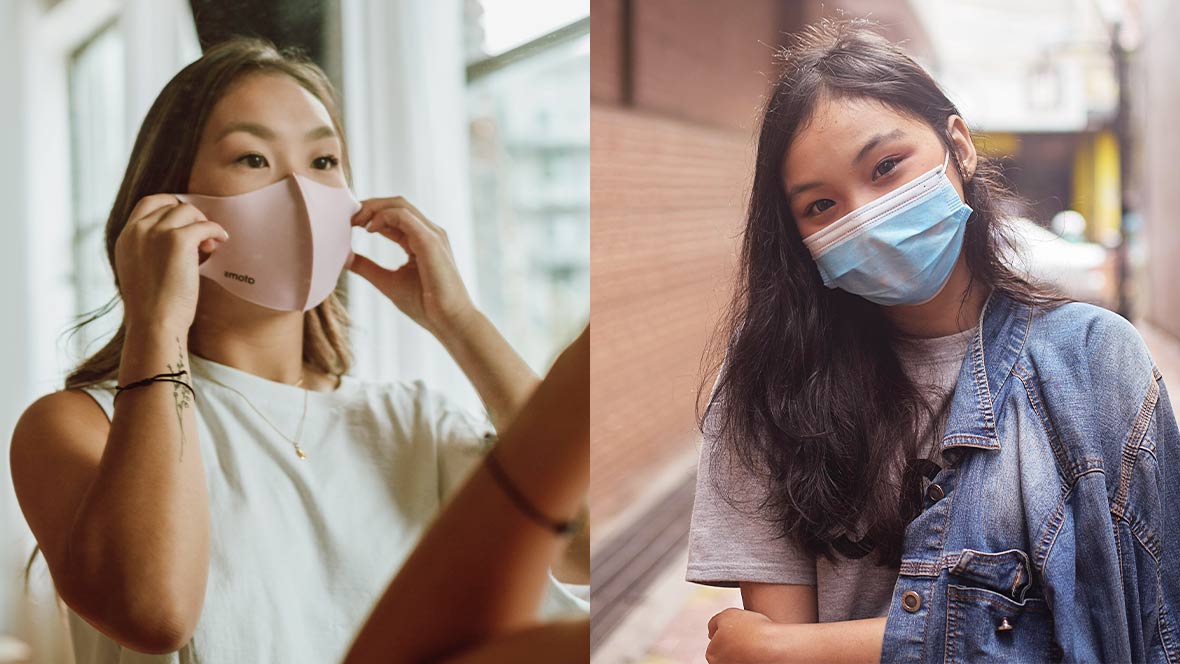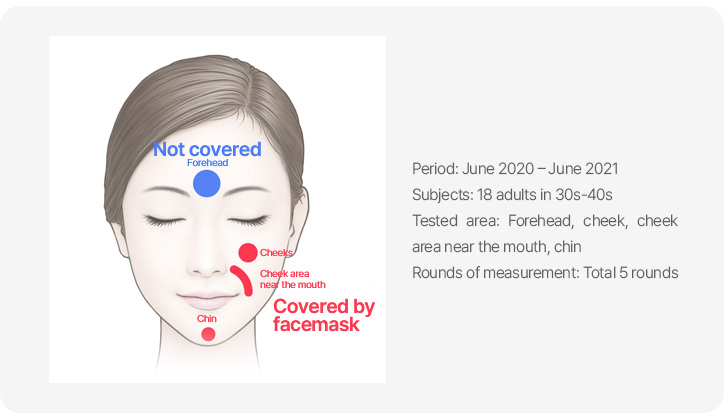
#4 COVID-19 Has Changed Our World. Has Our Skin Changed as Well?
20221213
Wearing a facemask has become a part of our daily routine in the
pandemic life. Because we are still required to wear a facemask
indoors, most office workers have their face covered for over 9
hours a day.
Extended hours spent under these masks have led to people
complaining about skin troubles around their mouth, chin, and
cheeks something they have never experienced before with more
people visiting their dermatologists due to these facemask-induced
skin problems. This summer, in particular, an increasing number of
people have been suffering from dermatitis induced by the early
arrival of the heat wave and the resulting humidity and
temperature leap inside the facemask.

- Period: June 2020 – June 2021
- Subjects: 18 adults in 30s-40s
- Tested area: Forehead, cheek, cheek area near the mouth, chin
- Rounds of measurement: Total 5 rounds
For the past two years, four seasons have passed twice while we have been wearing these guards. How has this protection against the virus changed our skin? According to LBLL, a research lab dedicated to studying the life of women today, the continued use of facemasks was found to have an influence on the skin’s moisture barrier, dryness, aging factors, and skin color. This suggests that putting on a facemask may induce skin problems and accelerate dermal aging.
First, the test shows a skin temperature increase after wearing a facemask in daily life for a year. Human skin doesn’t easily change because it tries to maintain its homeostasis, however, a constant exposure to the same stimulation can induce a gradual transformation. Increased skin temperature affects several skin factors. For example, a research found out that sebum release increased by around 10% when skin temperature rose by 1°C. (Sebaceous gland can explode when the skin base becomes heated, just like the way a volcano erupts after the earth becomes warmer.) Skin redness also increased. While the redness of the forehead, which stayed uncovered, was reduced by 2% compared to a year ago, but there was an increase of 3% on the cheeks within that same time frame.

The use of facemask also affects the skin’s moisture barrier. The amount of dead skin cells increased on areas covered by the facemask (cheeks, cheek area near the mouth and chin) as well as TEWL (moisture barrier assessment index). While there is the obvious influence of the changing seasons, the charts below show that the skin zones covered by a facemask experienced a bigger change overall. When theses skin zones become weak, the skin loses its elasticity, which affects the area of the pores. Compared to the forehead, a significant change in the size of pores has been observed from the cheeks after being covered by a facemask.

Normally, there are 100-120 pores on 1cm2 of skin and there is an
average of over 20,000 pores on the entire face. However, most
people don’t realize this because they are very small and hardly
seen on well-managed skin. Most women desire to have ‘poreless
skin that is as smooth as a peeled egg,’ but pores become enlarged
for several reasons and one of them is the release of sebum. When
sebum production increases, the pore becomes enlarged in order to
release said sebum. Another main reason is the loss of skin
elasticity. Pores don’t have any muscles and are in fact supported
by collagen and elastic fibers. Reduced elasticity weakens the
support and as a result, the pore sags naturally. Then there’s the
facemask creating an environment for greater sebum release and
loss of elasticity. The size of the pore is bound to become
larger.
Our world has changed due to COVID-19. Our skin is another thing
that has changed. The passage of time causes aging every year, and
this can become accelerated and intensified by wearing a facemask.
At the beginning of the pandemic, people thought that the facemask
would stay with us for only a short while. Our skin also assumed
that it wouldn’t last long and tried to maintain its homeostasis.
Now though, we may be adapting to the change, accepting it as part
of the outfit we’ll be wearing for the rest of our lives. Before
the outbreak, you may have believed that thorough cleansing and
skincare were enough, but now is the time we have to use a more
aggressive solution to soothe irritated skin that has lost is
moisture due to wearing these shields.






